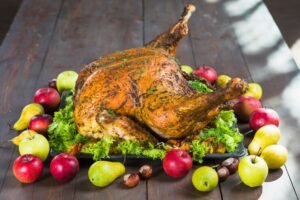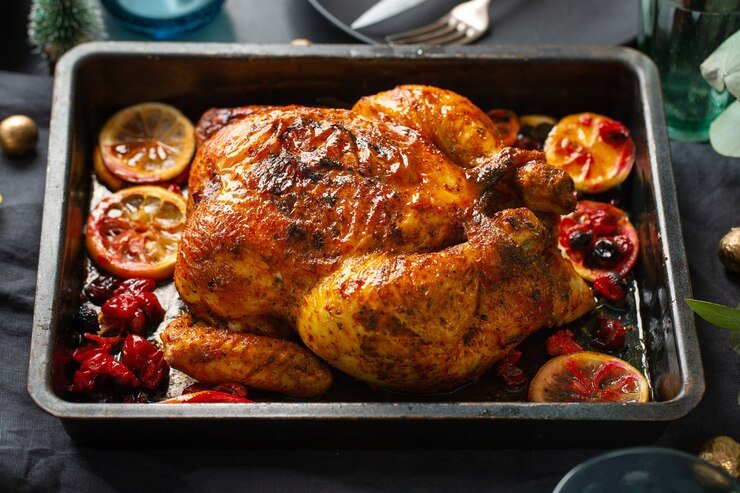Few dishes are as comforting as a juicy roasted chicken. This beloved meal is cherished across cultures for its combination of crispy skin and tender meat. Ideal for festive gatherings or simple family dinners, it’s a culinary staple that brings joy and satisfaction.
The Appeal of Juicy Roasted Chicken
Roasted chicken’s appeal lies in its simplicity and the deep comfort it provides. The aroma alone can evoke nostalgia and warmth, making it a favorite comfort food for many. Mastering the perfect roast involves basic skills and techniques that enhance the chicken’s natural flavors and textures, showcasing the cook’s prowess.
What You Will Learn
This guide will cover various essential techniques for Juicy Roasted Chicken, ensuring it comes out succulent and crispy. You’ll learn how to select the right chicken, season it effectively, and manage cooking times and temperatures. Additionally, you’ll explore how to enhance your dish with herbs, spices, and marinades, turning a simple chicken roast into a gourmet treat. By the end, you’ll know how to prepare a roasted chicken that delights at any dining table.
Preparation Techniques
Proper preparation is the key to achieving the perfect roast chicken. From cleaning the chicken properly to marinating and choosing the right stuffing, each step influences the flavor and texture of your dish. Here’s how to prepare your chicken to ensure it cooks perfectly and tastes delicious.
Cleaning and Patting the Chicken Dry
Start by thoroughly cleaning your chicken. Remove any leftover feathers and innards, and rinse the chicken under cold water. After cleaning, it’s crucial to pat the chicken completely dry with paper towels. A dry chicken skin is essential for achieving a crispy texture when roasted. Moisture on the skin will steam the chicken instead of roasting it, which prevents the skin from becoming crispy.
Marinating Tips
Marinating the chicken not only adds flavor but also tenderizes the meat, making it juicy and delicious. For a basic marinade, combine olive oil, lemon juice, minced garlic, and your chosen herbs and spices in a bowl. Rub the marinade thoroughly inside and out of the chicken. For best results, let the chicken marinate in the refrigerator for at least an hour, or overnight for deeper flavor. Ensure the chicken is covered or sealed in a bag to keep it moist and flavorful.
Stuffing Options and Preparation
Stuffing the chicken adds additional flavors that infuse into the meat as it cooks. Traditional stuffing options include a mix of breadcrumbs, herbs, and a little melted butter. For a more aromatic option, consider stuffing the cavity with whole herbs, garlic cloves, lemon halves, or even small onions. These ingredients release their flavors during cooking, enhancing the overall taste of the chicken. Make sure not to pack the cavity too tightly; air should circulate freely to ensure even cooking.
By mastering these preparation techniques, you ensure that your roasted chicken is not just cooked but crafted with care, resulting in a dish that’s both flavorful and inviting. Each step, from drying to stuffing, builds the foundation for a perfect roast.

Making the Gravy
A rich, flavorful gravy is the perfect complement to roasted chicken, capturing the essence of the bird’s natural juices enhanced with aromatic seasonings. Here’s how to craft a homemade gravy that will elevate your roast chicken to a new level of deliciousness.
Collecting the Drippings
Once your chicken is fully roasted, remove it from the roasting pan and set it aside to rest. This is the perfect time to start your gravy. Tilt the roasting pan and use a spoon or a baster to collect the drippings from the pan. These drippings are packed with flavor and are the base for your gravy. Strain them through a fine mesh to remove any solid bits, leaving you with a smooth liquid.
Creating a Flavorful Roux
To make the roux, which will thicken your gravy, melt equal parts butter and flour in a saucepan over medium heat. Stir the mixture continuously until it forms a smooth paste and starts to turn a light golden color. This process cooks the flour, removing its raw taste and preparing it to effectively thicken your gravy. Slowly whisk in the strained drippings, ensuring that each addition is fully incorporated before adding more. This gradual mixing helps prevent lumps from forming in your gravy.
Adjusting Thickness and Flavor
As the gravy simmers, it will begin to thicken. Monitor the consistency and add a little more broth or water if it becomes too thick. Taste your gravy and adjust the seasoning if needed, adding salt, pepper, or more herbs according to your preference. For extra richness, a splash of cream or a pat of butter can be stirred in at the end of cooking. Simmer the gravy until it reaches the desired thickness, then serve it hot alongside your roasted chicken.
This homemade gravy not only enhances the taste of your chicken but also utilizes every bit of flavor created during the roasting process, ensuring a delicious and satisfying end to your meal.



11 réflexions au sujet de “Juicy Roasted Chicken”